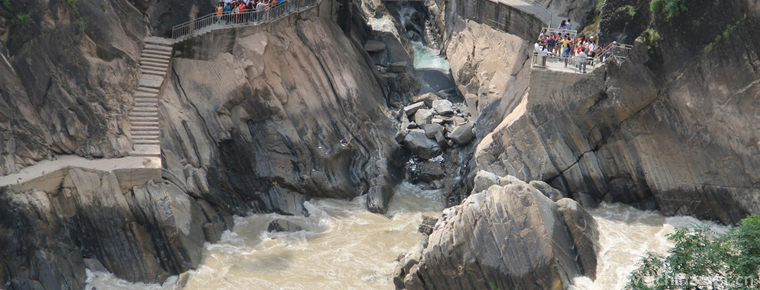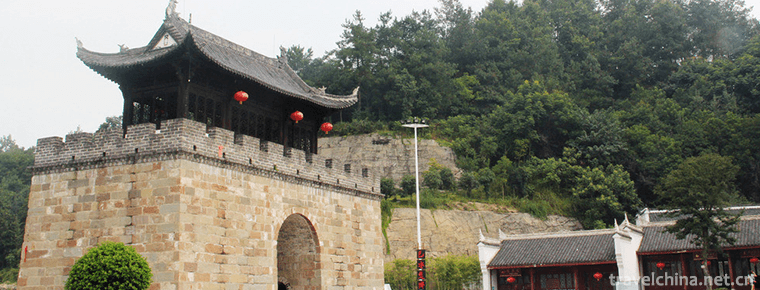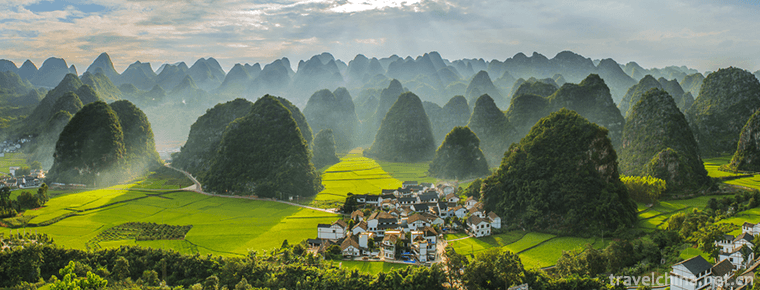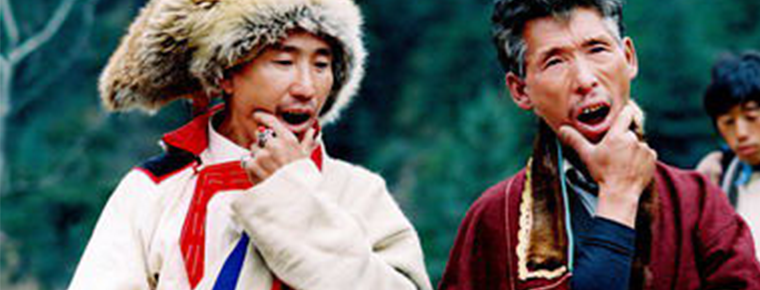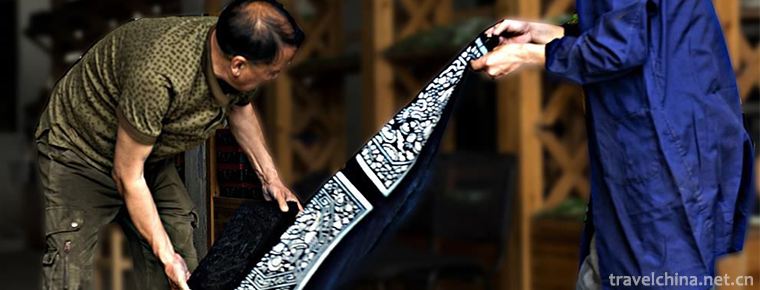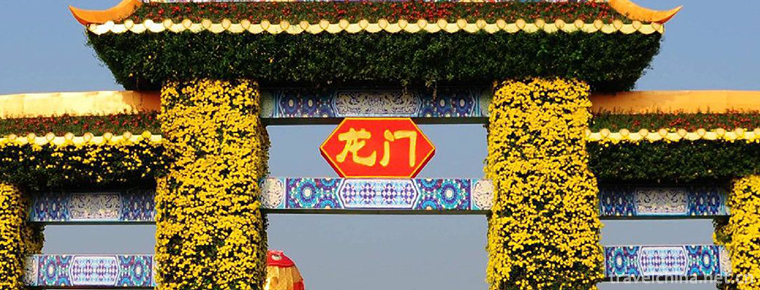Bao Zhai village
Baoqiao Village, formerly known as Baoqian Mountain and Qishan Mountain, is located in Luquan District of Shijiazhuang City, 16 kilometers away from Shijiazhuang, the provincial capital, and more than 200 kilometers away from Beijing. It is a famous ancient mountain village integrating history, humanity and natural scenery. It is a national 4A level tourist area, an advanced tourism unit in Hebei Province and a top ten tourist attraction in Shijiazhuang.
Baoqianzhai is situated in the North China plain to the East and Taihang group peaks to the west. It has a protruding peak and a magnificent and beautiful cliff. It looks like a giant Buddha lying on his back with his eyebrows close to his eyes. The top of the mountain is flat and open. It has 660 mu of fertile soil, with a depth of 66 meters. It is different from other places, with lush grass and trees. It has the reputation of "the world's miracle village" and "holding calves and blessed land".
Baoqiaozhai is not a village, but the name of a famous mountain. Located in Luquan District of Shijiazhuang City, it is a tourist attraction integrating natural and cultural landscapes. Baoqiaozhai is located 17 kilometers west of Shijiazhuang City. The mountains are majestic. Only one goat intestine path is accessible on the north and South slopes. Climbing to the top of the mountain, it was clear and bright. There are currently the largest mountaintop gateway in the country - Nantianmen, the country's first underground stone carving 500 Arhats Hall, the largest gold lacquer mural decoration of the Han Xin Temple and the Great Wall Zhai wall. The newly opened "Xiyuan - Lianhuashan - Baoqiaozhai" passenger ropeway, with a total length of more than 1800 meters, is the only passenger ropeway in China with a transfer station, no intermediate tower, fully enclosed round-trip passenger ropeway, and the highest suspended 271 meters. It has become a major landscape of Baoqiaozhai.
It belongs to the national 4A level scenic spot. Baoqiao Village is a famous ancient mountain village which integrates history, humanities and natural scenery. It is 580 meters above sea level, surrounded by cliffs and cliffs, with a flat top, 660 mu of fertile fields and 66 meters of soil depth. It was the ancient battlefield of Han Xin, the Yinhou of Han Huai in the Han Dynasty, and also the place where famous Taoist Zhang Sanfeng Chengdao set foot. Its scenery is unique and pleasant. It is known as the "paradise illusion, the blessed land on earth, the battlefield of soldiers, the paradise of peach blossoms outside the world".
Orion of the Name
In ancient times, Baoqizhai was called Wushan Mountain, which was the place where the soldiers of the Han Dynasty "held a banner and looked at Zhao Jun from Wushan Mountain on Jiandao Road" in the battle of attacking Zhao by Han Xin. It is said that during the Gerong Uprising in the Northern Wei Dynasty, the local people took the calf to the mountains to avoid the war, so they got the name of the calf. The mountain is surrounded by cliffs and dangerous roads, and there are more than 600 mu of arable land on the top of the mountain, so there is a folk saying that "holding calves (calves) up the hill, raising large farmland". In fact, it was written in the Jade Chamber of the Jin Dynasty earlier than the Northern Wei Dynasty, that is, the record of "Baoqiaoshan". "Baoqiao" is connected with "Zhai". In the late Jin Dynasty and early Yuan Dynasty, Jin set up Wuxian's troops at the top of the mountain to fight against the Mongolian army, so that the mountain has the name of "Zhai".
Characteristics of scenic spots
Baoqiaozhai is known as "the battlefield of soldiers, the blessed land on earth, the hallucination of heaven, the paradise of paradise". It faces the North China Plain to the East and the towering Taihang Mountains to the west, with a peculiar outline, one peak protruding and four walls cut like a cut. At sunset, if you stand in the northwest of the county and look at the village, the outline of the mountain looks like a giant Buddha lying on one's back. Buddha is a mountain, which is like a Buddha. The Buddha's manner is calm and quiet, looking up at the infinite space and time with the eyes of infinite wisdom. Visitors are amazed.
Baoqianzhai Mountain is steep and its cliffs are high, but its top is open and flat. It is an open and flat land. It used to have 600 mu of fertile fields and lush vegetation. Some tourists say that it is like a flower pot raised high, which is the heavenly pool surging green on the side of Taihang Mountain. Therefore, Baoqiao Village is also known as the "Peak Garden".
With its unique style, Baoqiaozhai stands out in the mountains and forms many natural wonders. Because of the steep mountains, only the South and North mountain roads can reach the top. Mountaineering on foot is accompanied by scenery and fine sightseeing. If you climb on a cable car instead of walking, you can have a high vision and overlook the peculiar mountain-like panorama of the holding calf village. In November 2001, Baoqiaozhai Scenic Area was rated as "4A" Scenic Area by the National Tourism Administration.
Historical culture
Baoqiaozhai has a long history and rich cultural accumulation. The long-standing military culture, Buddhist culture and Taoist culture blend with each other, forming the main vein of Baoqiaozhai culture. On the platform of the peak, there are Nantianmen, the largest mountaintop gate Fang in our country. There are Han generals who built Hanxin Temple for Huaiyin Hou during the First World War and their descendants. There are winding Great Wall around the mountain, 500 Lohan Hall on the top of the world, Jinque Palace, a famous Taoist Taoist temple, and so on. On it, people feel the smoke of the ancient battlefield and the strong religious atmosphere.
Baoqiaozhai is also an important place for religious activities. As early as the Tang Dynasty, Li Jifu's Tuzhi of Yuanhe Prefecture and County recorded that "those who hold the calf in the clouds have their own name in ancient times, that is to say, the Daoists call it"Beiyue Zuo Ming". The Mingshan Ji thinks that the number of blessed places can be avoided by the clouds." At the beginning of liberation, there were still Jinque Palace, Baiyun Temple and other religious palaces in Baoqiang Village. In Zhang Qifeng's poem Tiaowushan Shengji in the early Qing Dynasty, "Yao Chi is fruitful, Jiuling Xuanji is everywhere in Longdu domain", from which we can see the decline of Taoism and the prosperity of Buddhism. From the existing grotto statues and Buddhist scriptures, from Tang to Song, Jin, Yuan, Ming and Qing Dynasties, Buddhist activities flourished in Baoqiao Village, and the coexistence of two religions left a special cultural heritage for Baoqiao Mountain, which needs further development and research. In addition, the inscriptions left by the ancients on praying for rain, observing the sun, browsing banquets and other aspects, in order to become an important part of the cultural sites of Baoqiaozhai from another aspect.
In ancient times, there were 18 pools, Jiaolong Cave, fairy cave, Tianmen Cave, South Tianmen Gate, North Tianmen Gate, Wanghaiting Pavilion, Tianta Pagoda, Tianjing, Tianshu case and other misplaced landscapes.
It took only over a year for the people of Lulu to invest heavily in the development of Baoqiao village tourism. They rebuilt the scenic spots of Nantianmen, Beitianmen, Jinque Palace, Han Xin Temple and Bagua Array Labyrinth, and built a magnificent Great Wall along the cliffs, erecting an aerial ropeway across Lianhua Mountain to Baoqiao village. Tourists can take a cable car to the top of the mountain. There are horse stones, arrow chains, ancient spears and so on in the village. There are also various types of Buddhist stone carvings. On the east side of the eighteen pools in Shanyin, there are monks and nuns named by Emperor Qiwu of the Southern Dynasty who lived in Yongming for ten years. They are the earliest stone carvings in the mountain age. The Taoist Temple View of Baoqizhai is also well-known. A peach tree in Jinyin Palace in the village is said to have been planted by Zhang Sanfeng personally. Because of the dangerous location of Baoqiaozhai, all the past dynasties have been a place for military strategists to contend for. Naturally, there are many wars happening here, and most of them are found in the official history. But the war did not deprive Baoyao Village of its civilized glory. In 204 B.C., Han Xin, a general of the Han Dynasty, laid an ambush on the Wushan Mountains, fought against Zhao Jun in a battle against the backwater.
At the end of the Jin Dynasty and the beginning of the Yuan Dynasty, Gongwuxian of Jinhengshan mounted troops and built stockades here to fight against the Mongolian army. In Taoist classics, Baoqiao Mountain is also listed as the "Beiyue Zuo Ming". In Taoist classics, such as Tuzhi of Yuanhe Prefecture and County, Taiping Royal View and Taiping Laoyu Ji, it is recorded that Baoqianzhai is the blessed land of Taoism and the "assistant fate of Beiyue". Zhang Sanfeng, a famous Taoist scholar in Ming Dynasty, once visited the mountain and inscribed "Baoqianfu Land", which unfortunately does not exist today. However, the disciples of the "Sanfeng School" of Jinque Palace have been handed down from generation to generation, and have exerted a wide influence in the area of Huolu. Left behind a branch of the Sanfeng School, it has been handed down to this day, and the view of the palace still exists. Shifangyuan and Jinque Palace in Shijingcun are branches of Jinque Palace in Baoqianzhai. Guo Ziming, a disciple of the 16th generation of Sanfeng School, lived in Baiyun Cave in Shanyang, named himself Baiyun Cave, specializing in the Qing Dynasty, excelling in the tenets of "Morality" and "Huangting", which was the highway of the late Ming Dynasty.
Tourism Characteristics
The wonder of the calf is the creation of the wonder. It is adjacent to North China Plain in the east, Taihang Group Ranges in the west, Jinglonggu Road in the South and Hutuo Taotao in the north. Although it is only 580 meters above sea level, it is at the junction of high mountains and plains. There is no hill transition, which makes one hill stand out and emerge from plain to west. At this point, it is a spectacular situation. The walls of the mountain are like knives and axes, and only the North-South Bird's Road leads to the top of the mountain. Looking from the northeast, the mountain is like a giant Buddha lying on his back in the sky, with a serene look and beautiful eyebrows. It is amazing. The top of the hill is flat and flat, with a square area of more than 600 mu, a net soil layer of more than 60 meters, rich loam, lush grass and trees, like a park in the sky.
The beauty of the calf is in the natural scenery. As early as the Ming Dynasty, "Baoliu Qinglan" was listed as the first of the eight sceneries of deer, and was rated as the top ten sceneries of Shijiazhuang. Qiquan, waterfall, ancient cave, secluded land, mountain light, fog, sunshine and sunset constitute the natural scenery of Baoqiaozhai, which is like a dream of poetry, making people linger and forget to return. Such as the well-known "holding calf clear Lan", whenever the dawn begins and the new rain, or smoke around, the air is cloudy; or the blue sky is washed, the Red Cliff is condensed; or the endless clouds and waves, verdant and flying red; such as the opening of the sky, beautiful. Another example is the Eighteen Pools in Shanyin, also known as the Eighteen Springs. A cave is deep and unfathomable. The clear springs gush out and trickle down endlessly. In summer and autumn, springs surge, rush down, fall into waterfalls, sound heard for miles; in winter, fine water constant flow, layer upon layer frozen, forming an ice waterfall like jade, spring does not melt. The most amazing thing is that whenever the mountains and rains come, the cave first comes out with wisps of clouds and smoke, which is amazing.
Holding calves at sunrise is also a famous and exotic landscape. As early as the Song Dynasty, officials and dignitaries enjoyed watching the sunrise with their calves in their arms. For this reason, they also built a "pavilion for looking at the sea" on the mountain. As the east of Baoqiaozhai is the vast North China Plain, it has no shelter, climbs high and overlooks the whole area, thus forming an excellent position to watch the sunrise. Every morning, when Ling Dengzhaiding looks far into the East, the earth receives its gloom, clouds break open, and the morning light changes from gray to pale yellow, and from pale yellow to orange red. Then the whole East shows colorful clouds, or pieces, or folded layers, red and purple alternating with brilliance, instant change, endless eyes. Then, the whole sky became brighter, especially the unpredictable Oriental clouds. The speed was amazing. Sometimes it was like a wild horse galloping, sometimes it was like a golden dragon dancing, sometimes it was like a group of Phoenixes flying, sometimes it was like a peacock opening its screen. Half the sky's rosy clouds merge with the vast sea of clouds on the horizon, instantly dyeing a magnificent brocade, some flying away, some folding a piece, some embellishing it into flowers, its beauty is difficult to depict with pen and ink. In a word, the clouds and mists contrast with each other, the colors are incomparable, the glorious treasure flashes, and the nature's creation is amazing. The viewer is not only wearing sunrise, but also painted with a gorgeous, temporarily difficult to say on the color of the glory. A little hectare, surrounded by colorful rosy clouds, a slightly colored, by no means bright red sun wheel broke through the horizon, showing half a smiling face. This smiling face is not a very regular semi-circle. Her face is almost different from day to day. On that day, the wheel slowly rose to full, followed by a spectacular leap; only after that leap did she leave the horizon completely. Before this leap, however, the sun was not very round, mostly elliptical. Because of the short duration, many people will ignore this detail. When the wheel jumped off the horizon on the same day, it shined in all directions, the peaks were dyed, and the sky and the earth were full of vitality. At this time, people below the mountain will see the spectacular scenery of Danfeng Ninghui and the overflowing cliffs in Baoqiaozhai.
The cave of Baoqiaozhai is also one of the wonders. In addition to the above 18 pools, Tianmen Cave, fairy cave, patio, Jiaolong Cave, Baiyun Cave, Tibetan Jing Cave and other caves have their own characteristics, especially Tianmen Cave and patio. Tianmen Cave is located in the northeast corner of Zhaiding, also known as Dongtianmen, which is a natural and strange landscape. Its opening is on the cliff, such as a grand gate hole, magnificent; the most curious thing is that the top of the cave is open with the same huge "skylight", and there are steps to the top of the village. The whole cave is just like the kitchen stand of the peasant family in ancient times. Therefore, it is also called "pot-luang-zi" among the people. Looking up from the bottom of the mountain to the cave is like the "open eyes" depicted in "Water Margin", which is magical and mysterious. The patio, located in the southwest corner of Zhaiding, is a huge shaft with a diameter of about 20 meters and a depth of more than 30 meters. There are big trees in the well and bushes on the wall. There is a cave at the bottom of the cave which goes beyond the cliff, so it is also called "bottomless cave".
Major attractions
The main scenic spots in the scenic spot are Wolfgang, Nantianmen, Han Xin Temple, Dianjiantai, the Great Wall around the mountain, Tianmen Cave, Niulang Zhinu Jiaolongdong, Jinque Palace, 500 Arhats Hall, Qianlongbi, Paradise Street, Immortal Cave, Lianxinting Pavilion, Wanlian Yuan, etc. Among them, Tianmen Cave and Jiaolongdong Stone Carvings are the key cultural relics protection units in the province.
The Heavenly Southern Gate
Nantianmen, the largest Mountain Gate in China, is 13.9 meters high and 23 meters wide. It integrates the three arches into a whole, with a huge project and great momentum. It is very rare in the mountain top gate building in China.
Its walls are all decorated with white marble and painted in Hexi style. The interior and exterior paintings are ancient and elegant. The golden glazed tiles on the top of the door are even more magnificent under the sunshine. The 38-pier dome arch supports the golden top and overlaps staggeredly. Each dome is composed of 7 layers and 14 pieces, with varied outlines; eight eaves and warping angles, each angle is composed of 33 insertions, embellishing the South Tianmen with primitive elegance, extraordinary momentum, four red pillars, each with a diameter of 1 m and a height of 9 m, powerfully supporting the South Tianmen; two bronze-cast golden lions, up to three meters high, staring at both sides, are powerful and elegant. Rigorously guarding the South Tianmen Gate. Harmonious and subtle combination of colours makes it look like an archway from afar, but love to see is the doorway.
According to legend, Han general Han Xin led 30,000 generals to fight against Zhao. Want to hold the calf stockade, but after climbing the top of the stockade, how can not find the entrance to the stockade, is really no way to enter the mountain, no way to enter the stockade. At the moment of being helpless, suddenly, a white light flashed across the sky. A white-haired old man appeared in front of the generals. The old man swung his sword. A gate of heaven appeared in front of us. Originally, it was the Jade Emperor who was moved by the righteous teacher and sent mountain gods to guide the soldiers. Entering the South Tianmen Gate, the general suddenly opened up. The Zhaiding was like a flat ground, the temples and halls were scattered, the lotus flowers in the Tianchi Lake were reflected, sparkling, and the mountains were green and lush. The surrounding mountains were dancing like giant dragons. It's climbing mountains and mountains, taking off and moving forward...
According to the inscription on the mountain, Nantianmen was built in the Ming Dynasty. The rebuilding project is huge, and the single-door dome arch at the top of the building uses more than 40 cubic meters of first-class red. Standing at the South Tianmen Gate and looking at it from afar will make you relaxed and happy. Looking to the east, Lotus Peak and Conch Peak are near the foot of the ground, not far away is the vast North China Plain. The high-rise buildings of Shijiazhuang City, the provincial capital, are clearly visible. In the south, the train at the Shijiazhuang-Taiyuan Railway level pulls a whistle and carries Jin coal in all directions. On National Highway 307, buses and streams shuttle to and fro, carrying goods; in the west, Taihang Peaks fluctuate continuously, and Shang'an Power Plant can be seen in the steep mountains. Chimneys soaring into the clouds. White smoke is puffing out; looking north, the green surface of Huangbizhuang Reservoir is connected with the surrounding green mountains. The boat was vaguely visible swimming in the water. On the top of this high mountain, building such a magnificent gate can really be called "the first gate in the world".
cultural relics and historic sites
Baoqiaozhai is also rich in cultural relics, mostly concentrated in Jiaolong Cave, Tianmen Cave, fairy cave, Jinque Palace and other places. It mainly includes Buddhist statues, tourist inscriptions, poets'inscriptions, tablets, scriptures and couplets of stone inscriptions. Among them, Buddhist statues accounted for a large proportion, mostly in the Tang Dynasty, between the Song Dynasty and the Jin Dynasty, concentrated inside and outside Jiaolong Cave, with a total of 200 niches, Tianmen Cave and Fairy Cave also have a small number of remains. Among the precious relics are the Tang Dynasty's line-engraved Shadow Tu, which is a very rare Buddhist cultural relic. Most of the tourist inscriptions are relics of the Northern Song Dynasty, and the Tianmen Cave is the most, with a total of 18 places, including Jiaolong Cave, Xianren Cave and some other places. Among them, the most archaeological value is the inscriptions left by officials at all levels in the Song Dynasty when they came to Baoqiao Mountain to pray for rain. These inscriptions are not only exquisitely carved, but also true, grass, line and seal. They are colourful and have high artistic value of calligraphy. The poets'inscriptions are all works of Ming and Qing Dynasty except for one Song inscription poem in Tianmen Cave. Among them, the poems inscribed by Li Tengfang, a famous minister in the Ming Dynasty, and Zhang Qifeng, a deer-winner who served as Taishou in Hangzhou in the late Ming and early Qing Dynasties, are the most precious; the stone tablets are concentrated in Jinque Palace and Jiaolongdong, with 15 inscriptions on temples built in the Qing Dynasty, except for Li Tengfang's inscriptions on poems tablets and a Buddhist-roofed Sutra building in the first year of Chunhua in the Northern Song Dynasty (A.D. 1990). 。 Zhang Qifeng's Preface to the Establishment of the Jade Emperor's Chongge, Introduction to the Establishment of the Ancestral Temple of the Queen Mother, and A Tale of Jiaolong Cave in Jiaolongshan Mountain, written by Li Chun, an official of the Qing Dynasty, are the most graceful. There are three pairs of stone couplets, all in Jiaolong Cave in Shanyang. The second pair is Guo Baiyun, a Taoist monk who held Qianzhai in Chongzhen Ming Dynasty. They are carved on Jiaolong Cave and Baiyun Cave Pass respectively. The other is Zhang Shizhi, who prepared a book for Jinglongbing soldiers in the early Qing Dynasty. The book is engraved on both sides of a larger Buddhist niche. The pen goes with dragons and snakes. It is natural and smooth, and the carving is excellent. In addition to the five cultural relics mentioned above, Baoqizhai also retains such objects as iron kettle, arrow-bow, flagpole eye and ramming rice mortar in the Jin and Yuan Dynasties, which is sufficient to prove the history of Wuxian's military construction in this village in the late Jin Dynasty. In addition, there is a line of inscriptions carved on the stone wall by the golden soldiers when Wuxian was built in the cave of "immortal Kang" above the cliff, which provides strong evidence for that period of history.
Humanistic architecture
In addition to the natural landscape, Baoqiaozhai is more of a humanistic building. Its main buildings are: Nantianmen, the largest underground stone carving 500 Arhats Hall on the top of the mountain, Qianlongbi, Hanxin Temple, Huanshan Great Wall, Niulang Zhinu House, Jinque Palace Daoguan Ancient Building Group, Wanlian Garden, Lianxinting Pavilion, Paradise Street, Beitianmen, Bagua Array, etc. Among them, Nantianmen is not only famous for its grandeur, but also combined with the magnificent and magnificent features of ancient imperial buildings in northern China and the agile features of ancient buildings in southern Jiangsu. It complements each other and has its own characteristics. It is the landmark building of Baoqiaozhai. Luohan Tang is a large underground Buddhist temple built by making full use of the characteristics of thick soil on the top of the village. Among them, 500 Luohan statues are all carved with the blue stones of Luquan by the craftsmen of Quyang. Each Arhat is life-size and weighs about a ton. Five hundred Arhats have a huge lineup, a compact and reasonable layout and a magnificent momentum. The Qianlong Wall is 38 meters long, 13 meters high and 1.2 meters thick, all of which are made up of traditional glazed components. There are 999 sculptures of Dragons of all sizes, so it is called Qianlong Wall. Among them, there are nine main dragons on the front of the wall, each with a 1.5-meter-long Huabiao dragon pillar on the East and West ends; the back of the wall is composed of four big characters of "holding the calf" composed of glazed components, inscribed by Lu Jiaxi, former vice-chairman of the Standing Committee of the National People's Congress.
Traffic information
(1) In Shijiazhuang, you can go to Xinbai Square (formerly People's Market) and take the No. 5 Tourist Bus directly to Baoqiaozhai.
After arriving at the railway station, foreign tourists can take bus No. 320 to Baoqiaozhai directly, or bus No. 9, No. 20, No. 325 and No. 8 to Xinbai Square (formerly People's Market) and then take bus No. 5 to Baoqiaozhai directly. Tourists in Luquan City also take bus No. 3 to Baoqiaozhai directly.
(2) Driving southward along the Beijing-Hong Kong-Macao Expressway from Beijing, turning from Shitai Expressway to Shitai Expressway at the exit of Shitai Expressway, entering Luquan District at the exit of Luquan and reaching the scenic spot directly along Taiping Hebei Road. There are gas stations and repair points along the way.
Practical information
(1) Opening hours of scenic spots: 8:00-17:00
(2) No tickets for children under 1.2 meters in height and adult tickets for adults above 1.2 meters in height.
(3) No senior citizen ticket or officer ticket purchase
festival activities
The first month temple fair lasts from the first day of the first month to the fifteenth day of the first month.


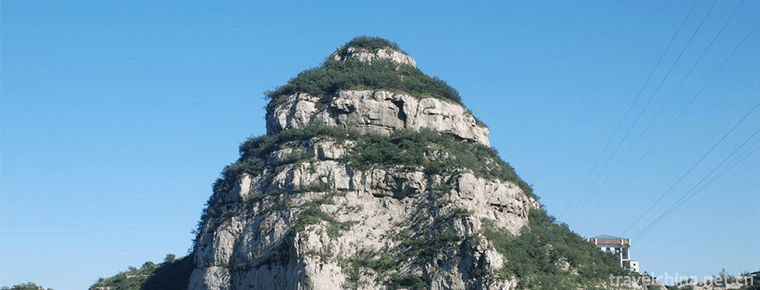
-
Tiger Leaping Gorge
Tiger Leaping Gorge, known as "danger", is one of the deepest canyons in China.
Views: 244 Time 2018-10-17 -
Quyuan Hometown Tourist Area
The cultural tourist area of Quyuan's hometown is located in Fenghuangshan, Zigui County, Yichang City, with a total area of 33.3 hectares in the north, Gaoxia Pinghu Lake in the north.
Views: 137 Time 2018-12-12 -
Wanfeng Forest Scenic Area
Wanfeng Forest Scenic Area, located in the southeast of Xingyi City, Guizhou Province, is the largest and most typical karst peak forest in China, with its magnificent momentum, peculiar shape and bea.
Views: 163 Time 2018-12-17 -
Bashang grassland
Bashang grassland, also known as the first grassland in the north of Beijing, is located in Hebei Province. It refers to the meadow grassland formed by the steep rise of grassland and the reasons of c.
Views: 116 Time 2019-01-02 -
polyphonic folk song
Multi-voice folk song refers to a couple or a group of singers singing two or more voices at the same time. Some people call it "two-voice folk song" and "polyphony folk song"..
Views: 126 Time 2019-04-28 -
Brewing Techniques of Sufu
Sufu brewing technology, the traditional technology of Haidian District, Beijing, is one of the national intangible cultural heritage..
Views: 142 Time 2019-04-30 -
Blue Clip Valerian Skills
Blue clip valerian technology, the local traditional printing and dyeing technology of Wenzhou City, Zhejiang Province, is one of the national intangible cultural heritage..
Views: 306 Time 2019-05-11 -
Leting drum
Music Pavilion Drum is a representative form of traditional music drum book and drum music in northern China. It is widely spread in eastern Hebei, Beijing, Tianjin and northeastern Liaoning, Jilin, H.
Views: 270 Time 2019-05-11 -
Cross stitch
Flower picking, a kind of drawing work, also refers to a needle method of embroidery, Chinese folk traditional handicraft. Also known as "pick weave", "cross embroidery", "cro.
Views: 229 Time 2019-06-21 -
Xiaolan Chrysanthemum Club
Xiaolan Town, located in the middle of the Pearl River Delta, is an important town in Zhongshan City, Guangdong Province. Xiaolan has the reputation of "Chrysanthemum City". Chrysanthemum cu.
Views: 270 Time 2019-07-06 -
Southwest University of Finance and Economics
Southwest University of Finance and Economics is a national key university under the Ministry of Education's "211 Project" and "985 Project" dominant disciplines innovation platfor.
Views: 153 Time 2019-08-31 -
Meishan climate
Meishan city is located in the middle and low latitudes, located in the west of Sichuan Basin and the middle reaches of Minjiang River. It is characterized by the alternation of sea land monsoon every year. It has four distinct seasons, mild climate, abundant rainfall,.
Views: 334 Time 2020-12-18
